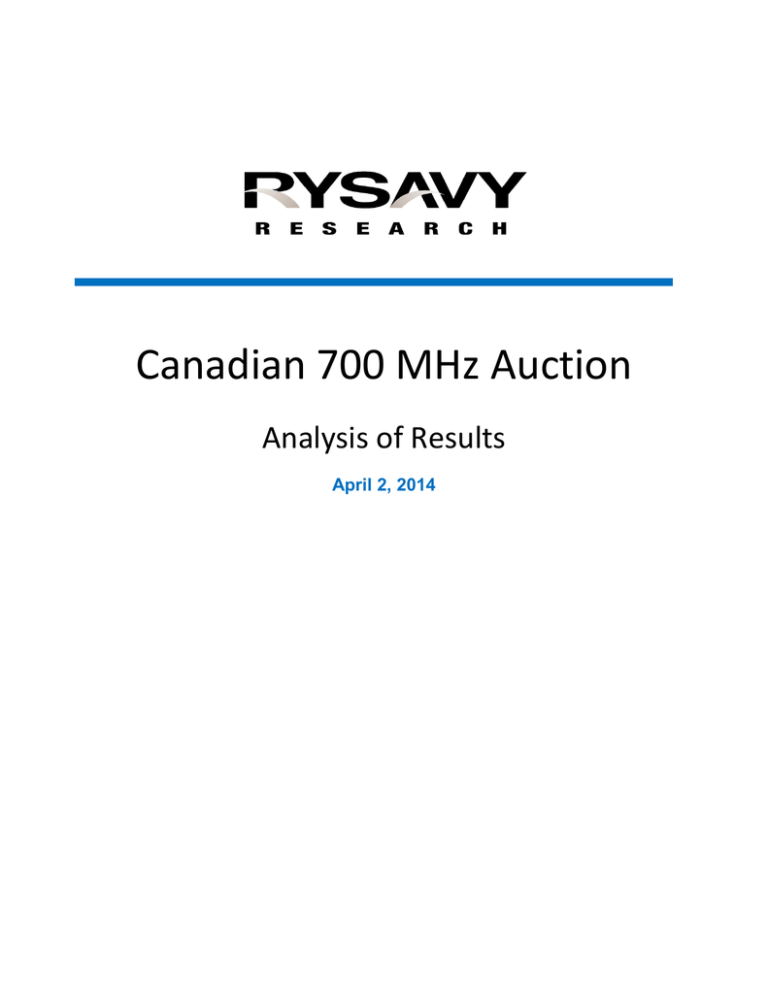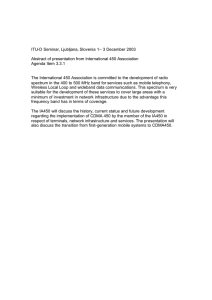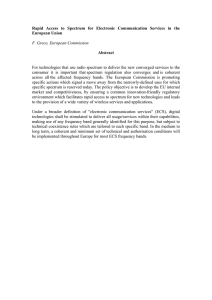
Canadian 700 MHz Auction
Analysis of Results
April 2, 2014
Auction Background
On February 13, 2014, the Government of Canada completed the auction of powerful new radio bands
that will augment Canadian cellular networks. Previously licensed for television ultra-high frequency
(UHF) bands, the new spectrum at 700 MHz consists of frequencies lower than any existing Canadian
cellular band. This new spectrum will not only add capacity, but the low frequencies will also efficiently
enable coverage in areas of lower population density and will provide good in-building penetration.
The band plan follows the one used in the U.S., where spectrum was auctioned in 2008. Although the
band plan is unique to North America, consistency with the U.S. ensures an ecosystem for devices and
infrastructure, and facilitates roaming between the two countries. In the U.S., the leading two
operators, AT&T and Verizon, have already made LTE using the 700 MHz band available to some 90% of
the U.S. population.
Canadian licensees included Bell, Bragg, Feenix, MTS, Rogers, Sasktel, TELUS, and Vidéotron. Of these
companies, Bell, Rogers and TELUS are the leading licensees. Rogers’ new spectrum covers 99.7% of
Canadian population, with contiguous A and B blocks covering 90.7%. A table of auction results is
available here.
Who, then, were the winners and who were the losers? And how is this determination made?
Aggregation Concepts
All spectrum is potentially valuable, but certain configurations are more useful than others and hence
more valuable. Because the capacity of a radio channel is proportional to its size (as measured in MHz),
today’s exploding demand for mobile broadband mandates the use of wider radio channels. LTEAdvanced includes a feature called carrier aggregation, which can combine radio channels in different
bands to create wider virtual radio channels.
Carrier aggregation, however, is neither a direct nor preferred substitute for wider initial radio channels
because it increases complexity due to the increased number of radios involved, and thus the cost of
both infrastructure and devices. Operators benefit from wider initial channels, which they can deploy
standalone, or aggregate with other channels to create even wider channels. Technology only allows a
limited amount of aggregation. The greater the size of each channel, the greater the net result.
Consequently, wider channels are always preferable, whether aggregated or not. Not only do users
experience higher average throughputs, but allocation of radio resources is more efficient than in radio
channels operating independently.
2
Analysis
Among the licensees, Rogers overwhelming acquired licenses that provide the greatest channel width,
namely the contiguous A and B blocks that enable LTE in a 10 MHz down and 10 MHz up configuration.
Not only can Rogers aggregate these bands with any of its other spectrum, but the large size of the
combined A and B blocks also makes a non-aggregated deployment practical and effective.
In contrast, competitors Bell and TELUS acquired spectrum that, in many markets, is divided between
lower and upper 700 MHz bands. Because transmit and receive frequencies are reversed in the upper
700 MHz band relative to the lower band, aggregation across these split bands is difficult, if not
impossible, from a practical point of view, since any solution would be unique to the Canadian market
and its relatively small market size.
Even in cases where aggregation is possible, in order to match Roger’s un-aggregated channel sizes,
competitors will need to aggregate two LTE-Advanced channels. Alternatively, if Rogers aggregates its
A/B channels with another channel, competitors would likely need to aggregate three channels, a
complex LTE-Advanced configuration envisioned for the future but not yet available.
Other licensees obtained unpaired spectrum (bands D and E) that they can use only by aggregating with
bands such as AWS or 1900 MHz. Paired spectrum, as obtained by Rogers, offers greater flexibility and
lowest-cost deployment options.
Rogers already has the densest Canadian LTE network, which it operates on Advanced Wireless Services
(AWS) bands at 1.7/2.1 GHz and on 2.6 GHz. Using its new 700 MHz spectrum, Rogers is in an excellent
position to both augment coverage, since fewer cells are needed than at high frequencies, and increase
capacity with carrier aggregation. Refarming 850 MHz spectrum in the future for LTE will provide Rogers
yet another way to increase capacity.
From a financial perspective Roger’s competitors, such as TELUS, may have obtained more spectrum at
lower cost, but the constraints discussed above make that spectrum lower quality. Rogers paid more but
obtained commensurate advantages. The price it paid, C$4.32 per MHz-POP (MHz times population
covered), is consistent with recent U.S. transactions for spectrum.
The device ecosystem is also important. Rogers obtained spectrum supported by band class 12 1, a band
that U.S. operators such as AT&T and T-Mobile use. Band class 12 spans 700 MHz A, B, and C bands. In
the U.S., the A band was initially less desirable due to potential interference from neighboring channel
51 high-power broadcast stations, but through technology improvements, operator efforts to resolve
1
As defined by the Third Generation Partnership Project (3GPP), which develops LTE specifications.
3
interference concerns, and the FCC moving channel 51 operations elsewhere, the A band is emerging as
a desirable and unencumbered band. In Canada, channel 51 concerns do not exist. Consequently, band
class 12-compatible devices will become readily available. In contrast, competitors using spectrum
across lower and upper 700 MHz bands will face greater ecosystem challenges since their spectrum is
not as well aligned with U.S. operators using those bands.
Finally, voice fallback also plays a role. For Rogers, voice falls back from LTE to its HSPA network, but
upper 700 MHz band Bell and TELUS devices based on the Verizon ecosystem will have to fall back to
outdated CDMA networks. Voice over LTE could eventually address this concern, but many LTE
operators have struggled with and delayed their VoLTE rollouts. In addition, VoLTE will require all new
devices.
Summary
Rogers won highly desired spectrum and their customers will enjoy the benefits of a well-executed
spectrum auction plan. The U.S. device ecosystem has evolved to make the A band spectrum much more
valuable. Rogers strategy of acquiring both A and B band contiguous spectrum gives Rogers a significant
advantage over the competition that has spectrum split between the lower and upper 700 MHz band.
Based on the spectrum factors discussed, including width of radio channels, paired spectrum, and
supporting ecosystem, Rogers emerges from this auction as an LTE powerhouse with a viable amount of
high-quality spectrum that will meet Canadian customer needs.
4
Notice
Rysavy Research provides this document and the information contained herein to you for informational
purposes only. Rysavy Research provides this information solely on the basis that you will take
responsibility for making your own assessments of the information. Although Rysavy Research has
exercised reasonable care in providing this information to you, Rysavy Research does not warrant that
the information is error-free. Rysavy Research disclaims and in no event shall be liable for any losses or
damages of any kind, whether direct, indirect, incidental, consequential, or punitive arising out of or in
any way related to the use of the information.
This analysis was sponsored by Rogers Communications.
About Rysavy Research
Rysavy Research, LLC is a consulting firm that has specialized in wireless technology since 1993. Projects
include analysis of spectrum requirements for mobile broadband, reports on the evolution of wireless
technology, evaluation of wireless technology capabilities, strategic consultations, system design,
articles, courses and webcasts, network performance measurement, test reports, and acting as expert in
patent-litigation cases. Clients include more than 75 organizations.
Peter Rysavy is a broadly published expert on the capabilities and evolution of wireless technology. He
has written more than 150 articles, reports, and white papers, and has taught more than 40 public
wireless courses and webcasts. He has also performed technical evaluations of many wireless
technologies including cellular-data services, municipal/mesh Wi-Fi networks, Wi-Fi hotspot networks,
mobile browser technologies, wireless e-mail systems, and social networking applications.
From 1988 to 1993, Peter was vice-president of engineering and technology at Traveling Software (later
renamed LapLink) where projects included LapLink, LapLink Wireless, and connectivity solutions for a
wide variety of mobile platforms. Prior to Traveling Software, he spent seven years at Fluke Corporation
where he worked on data-acquisition products and touch-screen technology.
Peter is also the executive director of the Portable Computer and Communications Association (PCCA,
http://www.pcca.org), an industry organization that evaluates wireless technologies, investigates mobile
communications architectures, and promotes wireless-data interoperability. Peter Rysavy graduated
with BSEE and MSEE degrees from Stanford University in 1979. More information is available at
http://www.rysavy.com.
Copyright © 2014 Rysavy Research, LLC. All rights reserved.
5




